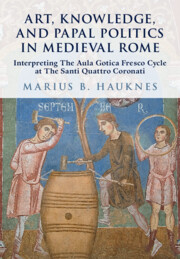 Art, Knowledge, and Papal Politics in Medieval Rome
Art, Knowledge, and Papal Politics in Medieval Rome Book contents
- Art, Knowledge, and Papal Politics in Medieval Rome
- Art, Knowledge, and Papal Politics in Medieval Rome
- Copyright page
- Dedication
- Contents
- Acknowledgments
- Introduction
- One The Santi Quattro Coronati Frescoes in Context
- Two Art, Learning, and Reflective Viewing
- Three Emblems of Time and Political Power
- Four Allegory, History, and Political Eschatology
- Five Visual and Material Entanglement in the Anagni Crypt
- Six Conclusion
- Appendix Inscriptions Appearing in the Aula Gotica Frescoes
- Bibliography
- Index
Six - Conclusion
Published online by Cambridge University Press: 30 January 2025
- Art, Knowledge, and Papal Politics in Medieval Rome
- Art, Knowledge, and Papal Politics in Medieval Rome
- Copyright page
- Dedication
- Contents
- Acknowledgments
- Introduction
- One The Santi Quattro Coronati Frescoes in Context
- Two Art, Learning, and Reflective Viewing
- Three Emblems of Time and Political Power
- Four Allegory, History, and Political Eschatology
- Five Visual and Material Entanglement in the Anagni Crypt
- Six Conclusion
- Appendix Inscriptions Appearing in the Aula Gotica Frescoes
- Bibliography
- Index
Summary
The preceding chapters have argued that the Anagni and Santi Quattro Coronati frescoes are products of the significant cultural and intellectual expansion that occurred in Rome and the papal state during the middle decades of the thirteenth century. In their own distinct ways, the two monuments brought together worldly and religious knowledge within stylistically uniform and spatially immersive pictorial programs. As assemblages of varied forms of learning, the two mural cycles invited reflective viewing, and in many cases required viewers to make interpretive connections between spatially distant images. Such dynamic interaction between educated viewers and architecturally embedded images could generate combinatory and associative interpretations that granted individual motifs new levels of meaning based on their relation to other images within the cycle. In this way, each monument functioned not only as a monumental image of the world’s knowledge but also as an interactive tool for philosophical thinking.
- Type
- Chapter
- Information
- Art, Knowledge, and Papal Politics in Medieval RomeInterpreting the Aula Gotica Fresco Cycle at Santi Quattro Coronati, pp. 291 - 304Publisher: Cambridge University PressPrint publication year: 2025
